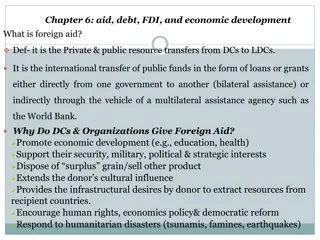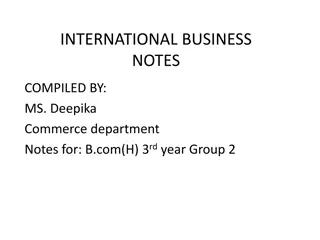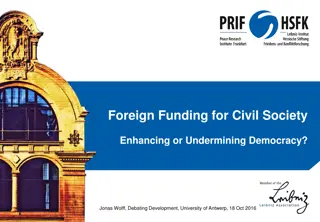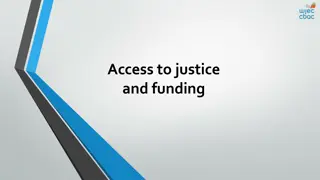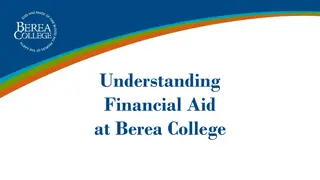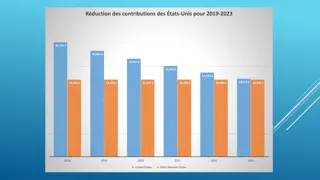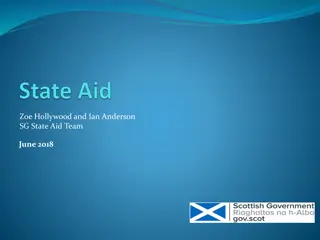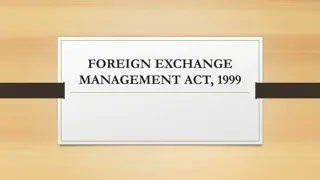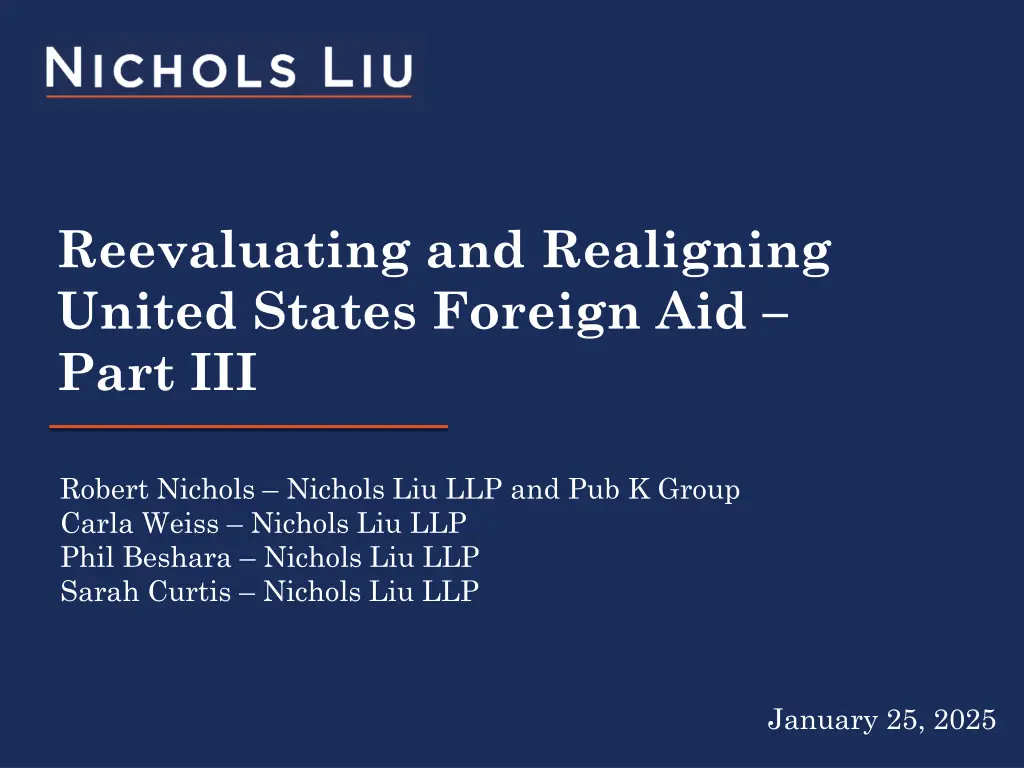
Reevaluating and Realignment of US Foreign Aid Principles
Explore important considerations and guiding principles for managing suspension of work orders in United States foreign aid programs. Learn about cost mitigation strategies and dealing with unmitigable costs during work stoppages to ensure effective program management.
Download Presentation

Please find below an Image/Link to download the presentation.
The content on the website is provided AS IS for your information and personal use only. It may not be sold, licensed, or shared on other websites without obtaining consent from the author. If you encounter any issues during the download, it is possible that the publisher has removed the file from their server.
You are allowed to download the files provided on this website for personal or commercial use, subject to the condition that they are used lawfully. All files are the property of their respective owners.
The content on the website is provided AS IS for your information and personal use only. It may not be sold, licensed, or shared on other websites without obtaining consent from the author.
E N D
Presentation Transcript
Reevaluating and Realigning United States Foreign Aid Part III Robert Nichols Nichols Liu LLP and Pub K Group Carla Weiss Nichols Liu LLP Phil Beshara Nichols Liu LLP Sarah Curtis Nichols Liu LLP January 25, 2025
Caveat Considerations, Not legal advice 2
Guiding Principles 1. Recognize that nobody knows yet when the suspension/stop work will be lifted for any given program or award, whether a particular program will be terminated, or which costs will be paid and when. 2. Highest priority is business continuity while the program review occurs 3. Three-pronged approach Complying with government obligations Minimizing costs Protecting cash 4. Make immediate decisions about cost incurrence: Safety and security Direct staff Other direct costs Indirect staff and costs essential vs. non-essential 5. Lead with open communications 3
FAR 52.242-15 Stop Work Order The contracting officer is allowed to require the contractor to stop all, or any part, of the work being performed for a period of 90 days (or longer if the parties agree). When a stop work order is received in writing, the contractor is required to immediately comply with its terms and take all reasonable steps to minimize the incurrence of costs during the period of work stoppage. 5
Stop Work Order: Cost Mitigation To mitigate costs, contractors should take the following proactive steps: Inform all employees to cease contract performance. Close existing charge codes. Create new charge codes for costs associated with the stop work / suspension period. Cancel travel and other avoidable expenses. Review local employment laws and employment contracts to assess the existence of severance provisions and notification requirements. Reassign employees to other projects (government or commercial) as feasible. Furlough or layoff employees who cannot be reassigned where cost savings outweigh required expenditures (such as severance). 6
Stop Work Order: Unmitigable Costs For any costs that cannot be mitigated, in order to be paid contractors must be prepared to justify their claimed costs and explain their necessity. For example, if a contractor continues to pay employees during the stop work period, whether the company can be reimbursed for these idle labor costs is fact specific and depends on showing that the company took all reasonable steps to minimize the incurrence of costs. 7
Stop Work Order: Idle Labor Cases The ASBCA found costs associated with direct labor during a stop work period reasonable where: The employees were entitled to severance pay so terminating them would not have saved money; The contractor limited expenditures by cancelling travel and other avoidable expenses; and While the contractor initially retained its staff, as the delay evolved, the contractor took increasing steps to reduce its staffing and limit its costs. In contrast, the Board denied a claim where the contractor sought to recover the salary of a key employee it hired for performance of the contract, and who was paid to do nothing during the pendency of the stop work. While it could be reasonable to have retained the employee, the company had not taken reasonable steps to minimize its costs. 8
Stop Work Order: Cost Adjustments Although the Government can make a contractor stop working, the contractor is nonetheless entitled to an equitable adjustment to address both cost and schedule. If the stop work order is lifted and work resumes, the contractor is entitled to an equitable adjustment if the period of work stoppage results in an increase in contract time or cost. If the stop-work order is not canceled, and the work covered is terminated for the convenience of the Government, reasonable costs resulting from the stop-work order will be part of the termination settlement. If the stop-work order is not canceled, and the work covered is terminated for default, the contracting officer shall allow, by equitable adjustment or otherwise, reasonable costs resulting from the stop-work order. 9
2 CFR 200.340 Termination Grants and agreements can be terminated if they no longer align with program goals or agency priorities. Neither the regulations nor the State Department Standard Terms and Conditions identify suspension as an option, yet it appears suspensions are occurring. Costs to the recipient or subrecipient resulting from financial obligations incurred by the recipient or subrecipient during a suspension or after termination are not allowable unless expressly authorized in the notice of suspension or termination or subsequently. Costs during suspension or after termination are allowable if: The costs result from financial obligations which were properly incurred by the recipient or subrecipient before the effective date of suspension or termination, and not in anticipation of it; and The costs would ordinarily be allowable. 10
2 CFR 700.14 USAID Suspension USAID may at any time suspend or terminate an award based on a finding that such assistance would not be in the national interest of the United States. At such time the recipient is prohibited from incurring additional obligations chargeable to the award other than those costs specified in the notice of suspension. If an award is suspended and the situation causing the suspension continues for 60+ calendar days, then USAID may terminate the award in whole or in part on written notice to the recipient and cancel any portion of the award which has not been disbursed or irrevocably committed to third parties. 11
Immediate Cost Issues Employees Continuing Work v. Furlough v. Layoffs Communications with Employees State, Local, and Home Country applicable laws Notice requirements (WARN Act) Travel Returning employees home? Are they in danger zones? Contractual Issues Subcontractors Leases Other Vendors 12
WARN Act: 29 USC 2101 et seq. Regs at: 20 CFR 639 et seq. Generally: minimum of 60 days notice to employees in advance of plant closing or mass layoffs Definitions matter Employer; Employment loss; Single site Exceptions Unforeseeable Business Circumstances Applies to plant closings and mass layoffs Circumstances not reasonably foreseeable circumstance is caused by some sudden, dramatic, and unexpected action or condition outside the employer's control A government ordered closing of an employment site that occurs without prior notice also may be an unforeseeable business circumstance. 20 CFR 639.9 (emphasis added). 13
Congressional & Agency Advocacy Sub-categories: coalitions within FA sector may find success in engaging with Agency and Congressional stakeholders Example: De-Mining Champions on Capitol Hill of specific programs/initiatives that meet three pillars of policy alignment: Safer Stronger More Prosperous House Minority Letter to Sec. Rubio (Link) The damage we risk is simply too high. For example, the President s Emergency Plan for AIDS Relief (PEPFAR) currently provides 20.6 million people across 55 countries with anti-retroviral treatment for HIV/AIDS. The President s Malaria Initiative (PMI) provides 37 million mosquito nets and malaria medicines to 63 million people to prevent further spread of one of the world s deadliest diseases. These lives depend on an uninterrupted supply of medicines, and your pause in funding will cost lives. 14
Possible Litigation Requests for Equitable Adjustment, Claims, Litigation over recoverable costs Impoundment Control Act The Constitution assigns to Congress the power to control the government s purse strings. This is perhaps the most important single curb in the Constitution on Presidential power. Congress implements its power through the annual budget and appropriations process and through a series of permanent statutes that establish controls on the use of appropriated funds. This legal framework is designed to combat abuses by the Executive Branch. Impoundment is any Executive action or inaction that temporarily or permanently withholds, delays, or precludes the obligation or expenditure of budgetary resources. With the ICA, Congress limited the President s ability to NOT spend appropriations as enacted. Possible private right of action by contractors and NGOs to enforce. 15
Requesting Guidance from State and USAID Communicating with agency leadership multiple times per day Aggregating questions from agencies to submit along with proposed guidance for the agency to consider Please submit questions to skrautner@nicholsliu.com 16
Questions? rnichols@nicholsliu.com cweiss@nicholsliu.com pbeshara@nicholsliu.com scurtis@nicholsliu.com 17


